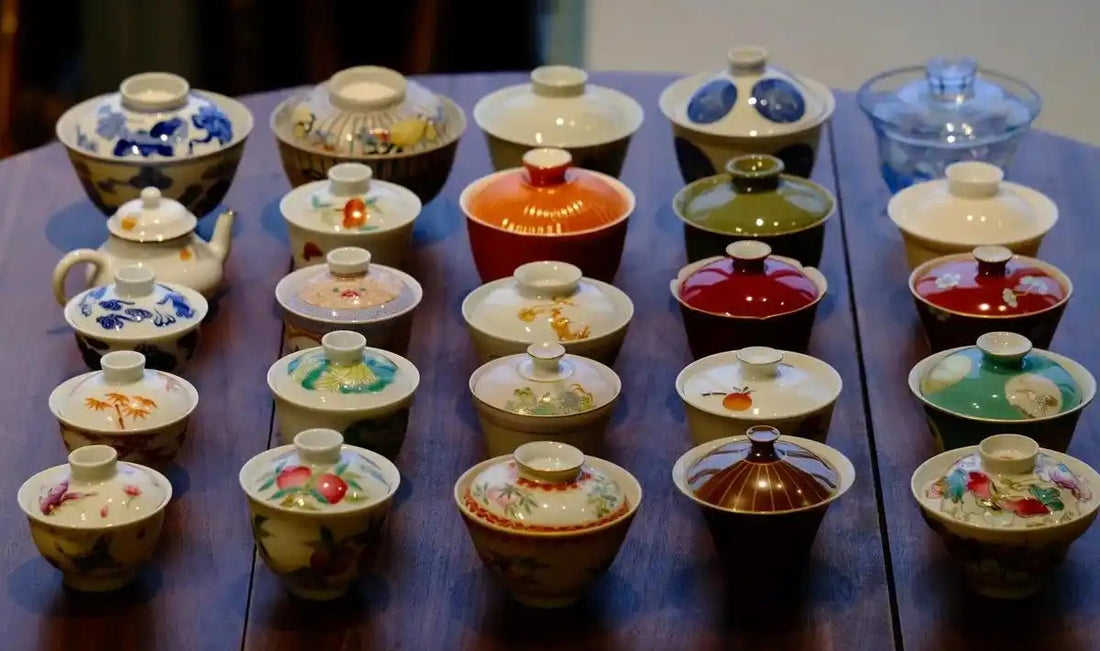
Appreciate Varieties of Gaiwan
ZenBrew Tea StudioThe Gaiwan, a staple in Chinese tea culture, has not only been treasured for its practical function but also admired for its diverse forms and exquisite craftsmanship. Different shapes often reflect varying eras, aesthetic philosophies, and regional preferences. Below is a closer look at several typical Gaiwan designs, each blending usability with artistic charm.
Horseshoe Gaiwan
Shaped like an inverted horseshoe with a wide mouth, slant-cut body, and a small flat bottom, this Gaiwan was popular in the Ming Dynasty in celadon or white-glazed versions. In the Yongzheng era of the Qing Dynasty, doucai horseshoe Gaiwans decorated with floral clusters became renowned. Despite its elegant look, the wide opening and shallow depth can make it prone to heat transfer, so caution is advised to avoid burns.
• Use Tip: Suitable for most teas, but be mindful of the hot rim when pouring or holding.
Conical Hat Gaiwan
As its name suggests, it resembles a traditional conical hat with a wide mouth, slanted body, and deep belly, resting on a short ring foot. The overall look is minimalistic yet stable, making it an ideal choice for both aesthetic appreciation and everyday tea tasting.
• Use Tip: Its deep belly accommodates tea leaves that expand significantly, such as rolled Oolong teas.
Hexagonal Gaiwan
Featuring a hexagonal rim with raised edges, a shallow belly, and a short foot, this design highlights a geometric form that suits modern or minimalist tea spaces. It offers a distinctive visual focal point among more typical round Gaiwans.
• Use Tip: May be preferable for those who value aesthetics and want to showcase a unique shape in their collection.
Bell Gaiwan
Designed with a slightly outward-flared rim and a lid that arches gracefully, this Gaiwan recalls the silhouette of a ringing bell. Its smooth lines and gentle curves impart a sense of calm, making it a standout piece for special tea gatherings.
• Use Tip: Works well with aromatic teas, as the lid shape helps concentrate the aroma.
Inverted Bell Gaiwan
Mirroring the outline of a bell, this Gaiwan is known for its regular contours that effectively concentrate the aroma of the tea. It suits most types of tea and lends a dignified, tranquil air to the tea session.
• Use Tip: Oolong and black teas benefit from the aroma-capturing shape; the tea’s fragrance stays nicely under the lid.
Chicken Heart Gaiwan
Distinguished by its deep, round swirl bottom that protrudes like a “chicken heart,” it carries auspicious symbolism and a clever ergonomic design. This shape balances visual appeal with practical function, making it a beloved item in tea ceremonies.
• Use Tip: The unique bottom design helps focus the tea leaves at the center, aiding flavor infusion.
Bamboo Node Gaiwan
Inspired by the segmented joints of bamboo, usually featuring two nodes, this Gaiwan has a hefty feel yet exudes elegance. Symbolizing integrity and resilience, it has been a favored choice among scholars.
• Use Tip: Ideal for slow, mindful brewing; the thicker walls often retain heat longer.
Lotus Leaf Gaiwan
Its saucer mimics a lotus leaf, complete with gently radiating veins, while the knob on the lid may be shaped like a lotus seedpod. Embodying poetic imagery and freshness, it brings to mind the soft fragrance of lotus ponds.
• Use Tip: Suited for delicate teas like white or floral teas that pair well with a serene aesthetic.
Glass Gaiwan
With a transparent body, the glass Gaiwan allows tea drinkers to observe the changing colors of the brew, making it especially suitable for floral or blooming teas. Under the right lighting, the tea’s hue glistens, adding visual delight to the tasting experience.
• Use Tip: Not the best for high-temperature or long steeps; be cautious with heat retention.
Folded Rim Gaiwan
Characterized by a flattened, outward-folded rim with raised edges, a shallow belly, and a short foot. Production of folded rim Gaiwans is now rare, making them highly collectible.
• Use Tip: Handle gently to avoid chipping the delicate rim.
Flared Rim Gaiwan
Possibly the most common type, this Gaiwan has a slightly flared rim that extends outward, reducing the chance of burning one’s fingers. Balancing style with daily practicality, it is an excellent all-round choice for most tea sessions.
• Use Tip: The flared rim design helps in smoother pouring, suitable for beginners.
Waist Fold Gaiwan
Featuring a subtly flared rim, a “fold” around the midsection (waist), and a round foot, this shape divides the Gaiwan into distinct segments. While its unique silhouette can hinder a perfectly smooth pour, it also showcases the artisan’s skill in ceramics.
• Use Tip: When pouring, tilt slowly to minimize splashing.
Square Gaiwan
A strictly square vessel, lacking the usual rounded curves, does not lend itself to typical brewing as the straight angles hamper water flow and proper steeping. Thus, it is generally used for displaying dry tea leaves or as a decorative piece rather than for actual infusion.
• Use Tip: Perfect for showpieces in a tea corner or for presenting specialty teas in a unique way.
Harmonious Gaiwan
With a gently bulging belly that offers ample space for leaves to unfurl, the Harmonious Gaiwan is popular in contemporary tea settings. Its smooth, rounded profile conveys a sense of completeness.
• Use Tip: Great for a range of teas, including green, white, or lightly oxidized Oolongs that expand significantly.
Chrysanthemum Petal Gaiwan
Shaped like chrysanthemum petals, with a wide opening, slightly flared rim, curved belly, and flat bottom. Each sculpted petal reflects exquisite craftsmanship, often linked with auspicious meanings akin to the flourishing nature of chrysanthemums.
• Use Tip: Complements floral or aromatic teas, enhancing the overall poetic atmosphere.
Melding Utility with Aesthetic Delight
Whether horseshoe-shaped or lotus-inspired, each variety of Gaiwan represents a unique dialogue between function, heritage, and artistic vision. Selecting a Gaiwan that resonates with your personal taste not only elevates the sensory pleasure of tea-drinking but also enriches the cultural and aesthetic aspect of daily life. In the gentle swirl of steam and the graceful lines of the vessel, tea and teaware unite to create a moment of serenity and wonder—an enduring charm that beckons tea lovers to discover and cherish.


